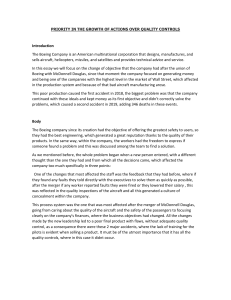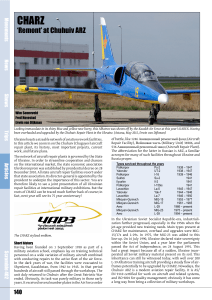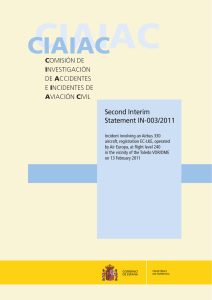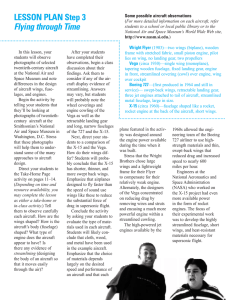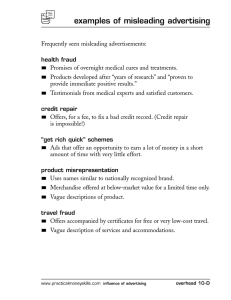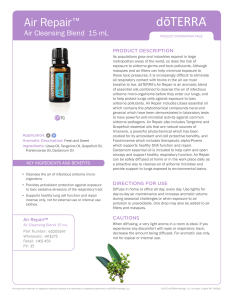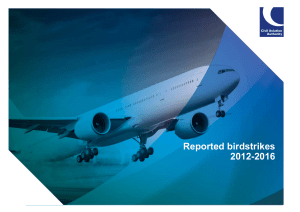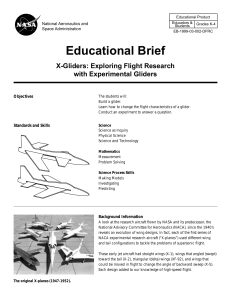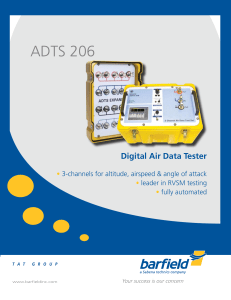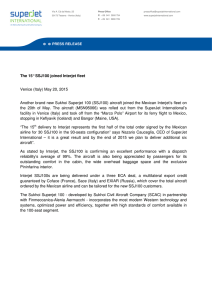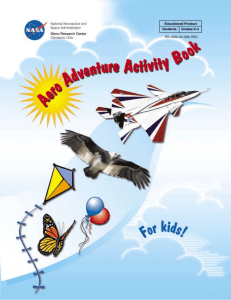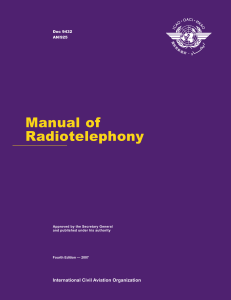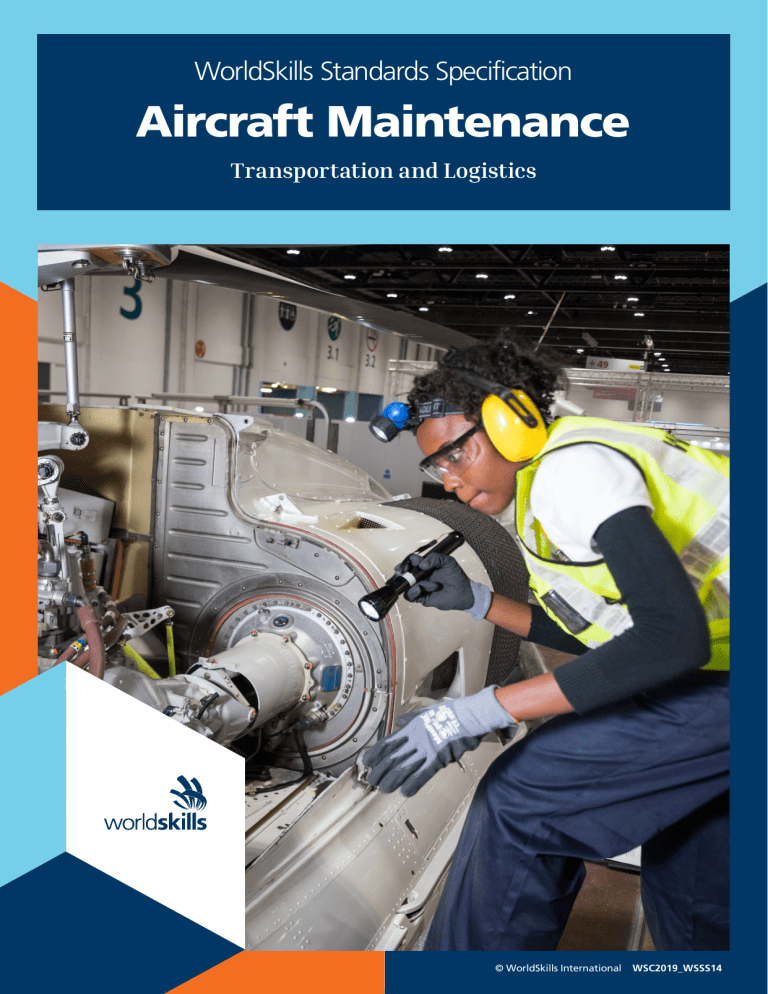
WorldSkills Standards Specification Aircraft Maintenance Transportation and Logistics © WorldSkills International WSC2019_WSSS14 THE WORLDSKILLS STANDARDS SPECIFICATION (WSSS) GENERAL NOTES ON THE WSSS The WSSS specifies the knowledge, understanding, and specific skills that underpin international best practice in technical and vocational performance. It should reflect a shared global understanding of what the associated work role(s) or occupation(s) represent for industry and business (www.worldskills.org/WSSS). The skill competition is intended to reflect international best practice as described by the WSSS, and to the extent that it is able to. The Standards Specification is therefore a guide to the required training and preparation for the skill competition. In the skill competition the assessment of knowledge and understanding will take place through the assessment of performance. There will only be separate tests of knowledge and understanding where there is an overwhelming reason for these. The Standards Specification is divided into distinct sections with headings and reference numbers added. Each section is assigned a percentage of the total marks to indicate its relative importance within the Standards Specification. This is often referred to as the “weighting”. The sum of all the percentage marks is 100. The Marking Scheme and Test Project will assess only those skills that are set out in the Standards Specification. They will reflect the Standards Specification as comprehensively as possible within the constraints of the skill competition. The Marking Scheme and Test Project will follow the allocation of marks within the Standards Specification to the extent practically possible. A variation of five percent is allowed, provided that this does not distort the weightings assigned by the Standards Specification. WSC2019_WSSS14_Aircraft_Maintenance Version: 1.0 Date: 25.10.18 1 of 10 WORLDSKILLS STANDARDS SPECIFICATION SECTION RELATIVE IMPORTANCE (%) 1 5 Work organization and management The individual needs to know and understand: • The Company Maintenance Policy Manual (MPM) • ATA chapters or equivalent • Health and safety legislation, obligations and documentation • Approved manuals, data from manufacturers and government • Situations when personal protective equipment (PPE) must be used, to include: safety footwear, eye and hearing protection, gloves, and respirators • Situations when electro-static dissipative equipment must be utilized to prevent system damage • The purposes, uses, care, maintenance and storage of hand, power and machine tools/equipment together with their safety implications • The purposes, uses, care and safe storage of materials • Sustainability measures with respect to the use of environmentally friendly materials, minimization of waste, and recycling materials • Principles of work flow, time management, and cost analysis • The importance of researching, planning, accuracy, checking, and attention to detail in all working practices • The significance of certifying the completion of a task to an international airworthy standard • The role of the certifying technician or engineer as the signing authority to release the aircraft for service • The importance of working within a team to accomplish a task within a timely and economical manner • The broader importance of working as a team • Individual roles and responsibilities within a team setting • Strength and weaknesses of team members and how to best organize the team to properly utilize all resources that are available WSC2019_WSSS14_Aircraft_Maintenance Version: 1.0 Date: 25.10.18 2 of 10 The individual shall be able to: • Consistently and diligently follow health and safety standards, rules and regulations • Identify and use the appropriate personal protective equipment including safety footwear, ear and eye protection • Select, use, clean, maintain and store all tools and equipment safely • Select, use and store all materials safely • Plan the work area to maximize efficiency • Maintain the discipline of keeping the work area clean and tidy • Measure accurately and check regularly • Consistently and diligently follow regulated processes and procedures to an international airworthy standard using the latest revision of approved manuals and data • Recognize the boundaries of own authority • Work to the requirements of the industry ‘Human Factors’ qualifications regarding the recruitment/employment of technicians • Establish and consistently maintain high quality standards and working processes under pressure • Plan the workflow within a team environment to give the best chance for a safe, successful competition of the task within a given time period • Organize and carry out a set of tasks within a team environment 2 Communication and interpersonal skills 5 The individual needs to know and understand: • The significance of establishing and maintaining customer confidence • The roles and requirements of related colleagues • The value of building and maintaining productive working relationships • The importance of having/developing an Industry accepted attitude, aptitude and ability: “Triple A” success • Interpersonal techniques of effective team work • The importance of swiftly resolving misunderstandings and conflicting demands • Human factors The individual shall be able to: • Interpret customer requirements and manage customer expectations positively • Make recommendations which meet/exceed the customers’ requirements and budget • Produce time estimate for customers or supervisors • Contribute positively to a team e.g. in order to maintain safety • Undertake investigative discussions e.g. to resolve technical problems • Keep colleagues regularly informed/updated on planned maintenance procedures and negotiate timings to minimize negative impact on work/productivity levels • Reflect positively and constructively to feedback on own performance • Recognize the needs of support organizations e.g. logistical supplier, engineering authority and manufacturers’ technical support WSC2019_WSSS14_Aircraft_Maintenance Version: 1.0 Date: 25.10.18 3 of 10 3 Problem solving, innovation, and creativity 5 The individual needs to know and understand: • The common types of problem which can occur within the work process • Conduct all activities in a manner to ensure an international airworthy standard is achieved • Diagnostic approaches to problem solving • The importance of following the latest revision of the manufacturer’s maintenance manual and documentation during the problem-solving processes • Trends and developments in the industry including new materials, methods and technology • Collaboration in a team environment to develop a course of action to complete task(s) safely and in an airworthy, timely, and cost-effective manner The individual shall be able to: • Check work regularly to minimize problems at a later stage • Challenge incorrect information to prevent problems • Recognize and understand problems swiftly and follow a selfmanaged process for resolving them using the latest revision of the manufacturer’s maintenance manual and documentation • Undertake fault diagnosis discussions with pilots to determine the underlying causes of technical problems • Persist in resolving complex problems • Recognize opportunities to contribute ideas to improve the product and overall level of customer satisfaction • Take ideas forward to management • Try new methods and embrace change • Exploit the potential of new technologies • Interpret and apply maintenance procedures • Encourage the checking and verification of one’s own work, as well as co-workers working in a team environment, to an international airworthy standard 4 Initial Scheduled Aircraft Acceptance Maintenance Check 12 The individual needs to know and understand: • ATA chapter(s) 05, 12 20, 51, 60 or equivalent • The Maintenance Policy Manual (MPM) • The Manufacturers Maintenance Manual, documentation including airworthiness directives, service bulletins, etc. • Maintenance Task Cards • Airworthiness responsibilities WSC2019_WSSS14_Aircraft_Maintenance Version: 1.0 Date: 25.10.18 4 of 10 The individual shall be able to: • Interpret and apply the appropriate maintenance manual and supporting approved documents, including task cards, that supports the scheduled acceptance inspection process • Accurately determine if an aircraft is safe for flight or if further inspection is required as per the Initial Inspection Checklist • Open and close a range of inspection panels • Operate systems as required to verify serviceability • Accurately complete corresponding documentation to reflect the status of the completed Initial Acceptance Check • Clearly and accurately document any defects and refer to the Technical Controller for his/her attention • Complete all tasks strictly adhering to the international airworthy standard 5 Aircraft structure repair (non-ferrous) 18 The individual needs to know and understand: • ATA chapter 51 or equivalent • Manufacturers’ structural repair manuals or equivalent • Engineering drawings and documentation • Different types of metal and their characteristics • Formulae for calculating bends and rivet lengths • Types of rivet and their purposes • Precision measuring instruments • Structural repair techniques • Damage reporting procedure • Implication of working with other technical entities (technical support, company approval process, etc.) with respect to effective communication and time delays The individual shall be able to: • Recognize the need for a repair and obtain an approved repair scheme • Interpret manufacturer’s engineering drawings for a range of complex repairs including but not limited to: channel insert repair, Lobster Back Bend, OGEE (curved bend), flush patch, longeron splice, and Joggled • Prepare a written damage report • Accurately calculate the dimensions for flat layout • Form a complex section and/or channel and fit as required to repair an assembly in accordance with Standard Practices (AC 43-13) • Bend sheet metal with a high degree of accuracy with corners rounded, smooth and nick free • Select suitable fastener type (solid rivet, blind rivet, hi-lok, etc.) • Layout fastener accurately determine the rivet length and install solid/blind rivets in accordance with the supplied engineering drawings • Evaluate completed repair and report any defects and inconsistencies to the Technical Controller • Certify work carried out in accordance with an airworthy standard WSC2019_WSSS14_Aircraft_Maintenance Version: 1.0 Date: 25.10.18 5 of 10 6 Composite structure inspection 12 The individual needs to know and understand: • ATA chapter 51 or equivalent • Engineering drawings • Manufacturers structural repair manual or equivalent • Manufacturers inspection criteria (visual, hammer/tap test, eddy current, etc.) • Different types of composite materials and their characteristics • Different types of composite repairs and their advantages and disadvantages • Implications of cost, time, material supply, and facility requirements of a given repair • Precision measuring instruments • Repair/fabrication techniques The individual shall be able to: • Recognize the need for a repair • Interpret manufacturer’s maintenance documentation and engineering data • Identify defects using visual, hammer/tap test • Develop hand-written repair schemes from standard/typical approved repair data using manufacturer’s documentation material data and industry standard practices (i.e. AC 43-13) • Utilize manufacturer’s structural repair manual or equivalent • Choose from a variety of standard minor field repairs using manufacturer’s approved data (panel edge potting, bonded/riveted metal patch, adhesive injection into a void, fiberglass layup, etc.) • Select approved composite repair materials from available stock • Estimate the down time, manpower requirements, and material costs to fully comply with repair scheme • Assess the economic viability of a given repair with respect to complexity and aircraft down time • Indicate critical environmental variables for repair accomplishment • Communicate with the Technical Controller to obtain a final authority for the repair scheme 7 Line Replacement Unit (LRU) Mechanical 18 The individual needs to know and understand: • ATA chapter(s): 22, 24, 31, 34, 45, 46 or equivalent • Critical interaction of aircraft systems with respect to multiple faults • Effects of the computer hardware and software interaction with other aircraft systems • Correct procedures for removing, inspecting, installing and testing LRU components • Part/component procurement procedures in accordance with company MPM • Economic effects with respect to cost, time, and materials of component replacement • The importance of aircrew defect reporting • General troubleshooting techniques applicable to all mechanical LRU components WSC2019_WSSS14_Aircraft_Maintenance Version: 1.0 Date: 25.10.18 6 of 10 The individual shall be able to: • Interpret flow charts, graphs and maintenance manual procedures for mechanical, hardware and software component systems • Accurately use the “on board” aircraft system which features (binary readouts, LEDs, alpha-numeric display, fault codes) to analyse and troubleshoot the faulty aircraft system • Refit aircraft component using manufacturer’s procedures • Verify the airworthiness status using built-in test equipment (BITE) • Identify defective component(s) through system analysis • Economically assess the defect with respect to cost, time and materials • Repair a wide variety of aircraft systems by replacing major LRUs and electrical sub-components (relays, switches, circuit breakers, connectors, etc.) • Economically repair an aircraft system with respect to cost, time, and materials • Prepare action plans detailing the troubleshooting process, repair recommendations and additional operational checks to the Technical Controller for verification 8 Line Replacement Unit (LRU) Electrical 15 The individual needs to know and understand: • ATA Chapter(s): 22, 23, 24, 31, 34, 45, 46, or equivalent • The importance of communicating with other teams when troubleshooting affects multiple systems • Electrical safety with respect to power-on troubleshooting steps • Safe use of test equipment during testing procedures • Effects of Electro-Static Discharge (ESD) on sensitive components and how to reduce or eliminate potential damage • Effects of the computer hardware and software interaction with other aircraft systems • Correct procedures for removing, inspecting, installing and testing LRU components • Part/component procurement procedures in accordance with company MPM • Economic effects with respect to cost, time and materials of component replacement • The importance of aircrew defect reporting • General troubleshooting techniques applicable to all electrical LRU components WSC2019_WSSS14_Aircraft_Maintenance Version: 1.0 Date: 25.10.18 7 of 10 The individual shall be able to: • Interpret flow charts, graphs and maintenance manual procedures for electrical, hardware and software component systems • Accurately use the “on board” aircraft system which features (binary readouts, LEDs, alpha-numeric display, fault codes) to analyse and troubleshoot the faulty aircraft system • Refit aircraft component using manufacturer’s procedures • Troubleshoot utilizing electrical test equipment (i.e. digital multimeter) • Verify the airworthiness status using built-in test equipment (BITE) • Identify defective component(s) through system analysis • Economically assess the defect with respect to cost, time and materials • Repair a wide variety of aircraft systems by replacing major LRU’s and electrical sub-components (relays, switches, circuit breakers, connectors, etc.) • Economically repair an aircraft system with respect to cost, time, and materials • Prepare action plans detailing the troubleshooting process, repair recommendations and additional operational checks to the Technical Controller for verification • Manage the effects of the computer hardware and software interaction with other aircraft systems. 9 Certification and Return to Service procedure 10 The individual needs to know and understand: • ATA chapter(s) 05, 10, 11, 12, 24, 27 or equivalent • The impact of accurately recording completed reports • The effect and consequences on the aircraft systems when a scheduled inspection has been completed • Correct procedures for “Returning Aircraft to Service” including Minimum Equipment List (MEL) • Significance of the following certifying statements: • “The maintenance described has been formed in accordance with the applicable standards of airworthiness” • “Aircraft is fit and safe for flight in conformance with its type design” • The impact of defect deferrals on aircraft serviceability • Intended use of an aircraft Minimum Equipment List (MEL) or equivalent with respect to aircraft dispatch • Effects of repairs and modifications to the aircraft “empty weight and balance report” calculation as per manufacturer’s procedures • The organization of documents with respect to aircraft manufacturer maintenance documents including task cards • Certifying technician/engineer’s responsibilities for aircraft certification for return to service • How to determine if aircraft weight and balance report revisions are required and how to proceed if necessary WSC2019_WSSS14_Aircraft_Maintenance Version: 1.0 Date: 25.10.18 8 of 10 The individual shall be able to: • Evaluate work order packages and develop plans for aircraft certification • Interpret defect and rectification reports including task cards by following the maintenance manual procedures using the latest amendments • Ensure the aircraft is fit and safe to fly in accordance with its type design and determine all outstanding maintenance requirements to achieve an airworthy status • Prepare aircraft journey logbook entries (with maintenance summaries and maintenance release) for the work carried out in the work order packages that reflect the current state of the aircraft • Prepare acceptance reports for the incoming aircrews Total WSC2019_WSSS14_Aircraft_Maintenance 100 Version: 1.0 Date: 25.10.18 9 of 10 REFERENCES FOR INDUSTRY CONSULTATION WorldSkills is committed to ensuring that the WorldSkills Standards Specifications fully reflect the dynamism of internationally recognized best practice in industry and business. To do this WorldSkills approaches a number of organizations across the world that can offer feedback on the draft Description of the Associated Role and WorldSkills Standards Specification on a two-yearly cycle. In parallel to this, WSI consults three international occupational classifications and databases: • ISCO-08: (http://www.ilo.org/public/english/bureau/stat/isco/isco08/) • ESCO: (https://ec.europa.eu/esco/portal/home) • O*NET OnLine (www.onetonline.org/) This WSSS (Section 2) appears most closely to relate to Aircraft Mechanics and Service Technicians: https://www.onetonline.org/link/summary/49-3011.00 and/or Aircraft Maintenance Technician: http://data.europa.eu/esco/occupation/91373a70-79b6-47a2aa50-07dfe20dd258 Adjacent occupations can also be explored through these links. WSC2019_WSSS14_Aircraft_Maintenance Version: 1.0 Date: 25.10.18 10 of 10
